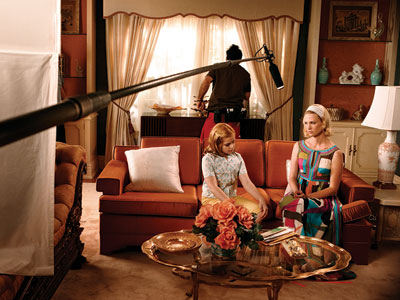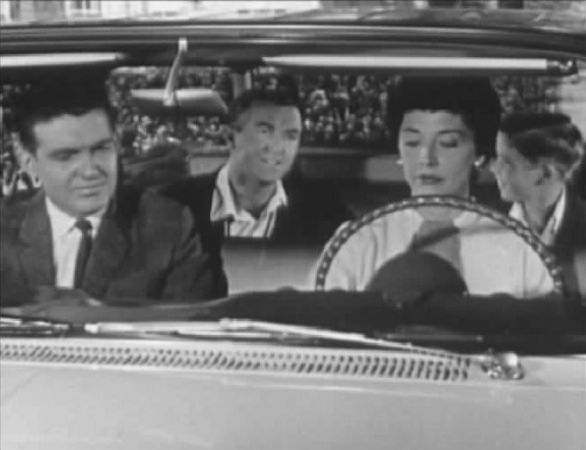Difference between revisions of "Sound (Discussion)"
From Screenpedia
Jump to navigationJump to search (→2. Sound perspective, time, and the diegesis: changed to "intradiegetic") |
|||
| Line 47: | Line 47: | ||
##**NARRATION, ADULT MALE VOICE: What do I think? I think that, to this day, there's no feeling quite like sitting in that Chevy for the first time. Feeling the rumble of the engine, and not having to listen to MOM complain about the door anymore. Chevrolet, dependable luxury yesterday, today, and tomorrow. | ##**NARRATION, ADULT MALE VOICE: What do I think? I think that, to this day, there's no feeling quite like sitting in that Chevy for the first time. Feeling the rumble of the engine, and not having to listen to MOM complain about the door anymore. Chevrolet, dependable luxury yesterday, today, and tomorrow. | ||
--> | --> | ||
| − | ##Finally, describe new audio for the scene that illustrates the difference between '''diegetic vs. | + | ##Finally, describe new audio for the scene that illustrates the difference between '''diegetic vs. intradiegetic sound'''. '''Briefly explain how your audio does so.''' |
<!-- | <!-- | ||
##*During the entire scene there would be the lingering of an eerie theme rumbling in the background, a sound that us, the audience, could only hear. This non-diegetic sound bit would signal to us that something is off about this situation. Whereas the siren, a diegetic sound would be a sound that both the characters and the audience would hear. | ##*During the entire scene there would be the lingering of an eerie theme rumbling in the background, a sound that us, the audience, could only hear. This non-diegetic sound bit would signal to us that something is off about this situation. Whereas the siren, a diegetic sound would be a sound that both the characters and the audience would hear. | ||
Revision as of 15:33, 6 October 2020
Purposes of sound on television
Television lists four "purposes of sound on television":
- Capturing viewer attention.
- Manipulating viewer understanding of the image.
- Maintaining television flow.
- Maintaining continuity within individual scenes.
Sound technology
- What are the different types of microphone pick-up patterns? How do they affect sound perspective? (Ugly Betty example.)
Sound exercises
1. Sound-image interaction
A Dodge commercial exercise provides examples of how sound can manipulate viewer understanding of the image--that is, can change its meaning.
- The textbook discusses the impact of Gymnopedie No. 1 and "Solidarity Forever." What do you think is the effect of each of the additional pieces of music available online here.
- Henri’s Notions, "Mrs. Kelly’s Chickens/Louis Waltz"
- Huxford Symphony Orchestra, Tchaikovsky Symphony No. 4
- Jake Berry, "Walking"
- "Movie music": "Invaders from Mars"
- Extra credit (two points):
- Choose a well-known song that, if laid over the commercial, would change its meaning. (No R-rated songs, please.)
- Create a new video that uses the Dodge commercial, but replaces the original sound with this song.
- Upload the video (probably to Blackboard) to share it with the class.
- Write a short explanation of how you feel your song changes the meaning of the commercials images.
2. Sound perspective, time, and the diegesis
- Each group: Think back to the Chevrolet commercial that we broke down and the shot of Mother, salesman, Father, son in the car. As a group, pretend you're doing ADR (and what is ADR?) and sound mixing for this shot:
- Write dialogue and/or specify sound effects that illustrates how sound editors can manipulate sound perspective to alter our understanding of a scene (somewhat like the sound editor of Ugly Betty did in the textbook example, but do not copy it). Briefly explain how your audio does so.
- Illustrate how sound and time could be manipulated in this shot, creating new dialogue and/or other audio to lay over the image (as in the textbook's example from Damages). Briefly explain how your audio does so.
- Finally, describe new audio for the scene that illustrates the difference between diegetic vs. intradiegetic sound. Briefly explain how your audio does so.
Types of sound
- What are the three main types of sound in TV production and how do digital audio workstations mirror those three types? (See Ugly Betty ProTools layout for music editor.)
- What is "public domain" music? What are "master rights"? How do master rights apply to DVD releases of TV programs?
Bibliography
- Butler, Jeremy G. Television: Visual Storytelling and Screen Culture. New York: Routledge, 2018.

